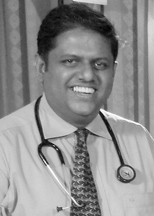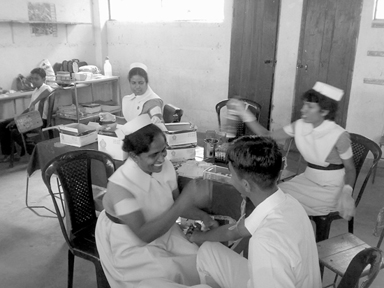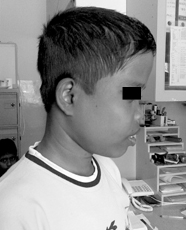|
Preventing thalassaemia:
Matchmakers have a role to play
by Nilma DOLE
|

Dr. Ashok Perera
|
“I remember a boy called Nimal whom I took to see the film ‘Sooriya
Arana’. He asked for icecream upon seeing the ice-cream truck, but I
couldn’t buy him one since he had diabetes due to thalassaemia,”
reminisced Dr.Deepika Wanarambe, a doctor who has seen the pain and
trauma of thalassaemia patients at the Children’s Thalassaemia Ward of
the Badulla General Hospital.
She went on to talk about a girl named Geethani who was a talented
artist.
“She drew lovely pictures of her home and the hospital because she
couldn’t go to school. Geethani even drew me while I helped her with her
blood transfusions,” said the doctor with tears in her eyes. Sadly,
Nimal died due to extreme diabetes when he was 12 years old (he had a
twin brother who is normal) and Geethani died when she was 10 years due
to arthritis. These children suffered from thalassaemia that affects the
red blood cells because iron isn’t stored by the haemoglobin in the red
blood cells, causing deformities and malfunctions in the victims’ body
and bone development.
 |
|
Testing for thalassaemia
|
Such children are unfortunate to fall victim to the disease due to
the ignorance of their parents who didn’t check their blood before they
had children.
“The reason thalassaemia continues to affect our population is
because we don’t have proper genetic counselling at our local
hospitals,” said Dr.Rohana Dayaratne of the Poison Unit at the Colombo
General Hospital.
He emphasized that every major hospital and dispensary should have a
genetic counselling section to enlighten couples if they were to have
children.
“Thalassaemia is a preventable disease, but if two thalassaemia
carriers get married, they have a 25 percent chance of having a
thalassaemia-affected child. So it is imperative that we counsel couples
before they have children, otherwise they will suffer in the long run,”
he said. The problem with general hospitals is that the out-patient
department is so crowded that it is difficult for proper doctor-patient
relationships to be formed.
 |
|

Children suffering from
thalassaemia |
With the goal to have a ‘Thalassaemia-Free Wayamba by 2020’, it is
important not just for doctors to educate patients, but matchmakers and
marriage brokers, the famous `kapuwa’, should emphasise that unless the
couple check their blood to determine if they carry the thalassaemia
gene, they shouldn’t marry.
“In matchmaking, they match the 21 `porondam’. Likewise, checking for
the thalassaemia carrier gene should be considered as the 22nd `porondam’.
This is vital,” said the doctor.
A main step in thalassaemia prevention is to inculcate it into the
school curriculum because we should ingrain it in the youth to check
their blood before they look for a partner. “We can’t prevent
thalassaemia carriers from getting married, but we can educate them
properly so that they are aware of thalassaemia”, he said. One solution
is to stop marriage between close relatives as there’s more chance of
the affected gene to occur in the same family circle.
National centre
Further enlightening the public about thalassaemia in Sri Lanka is
Dr. Ashok Perera, the Doctor-in-Charge of the National Thalassaemia
Centre (NTC), Kurunegala Teaching Hospital. He said that a colossal
amount of Sri Lanka’s health budget goes just for treating thalassaemia.
“At the moment, 5-7% of the total health budget goes for thalassaemia
patients. About Rs. 400,000 is spent annually just for treatment to
ensure that the patient lives,” said Dr. Perera.
Ever since the National Thalassaemia Centre opened in 2006, there
have been many welfare activities for the patients which have benefited
them immensely.
“We have done Cascade Screening where we checked the blood of the
thalassaemia patients and have given them green and pink cards as
certificates, to get married to others who will be tested as well,” said
Dr. Perera. He added, “We have educated village leaders, Government
Agents, Grama Niladaris, religious leaders and teachers on thalassaemia
and have asked them to spread the message. We have also lectured youth
at various institutions about thalassaemia.”
The NTC has received the support of key stakeholders like the Rotary
Club of Athugalpura, the Lions Club of Kurunegala, Vicki and Vimaladarma
Trust Fund and World Vision in this regard. “In addition to these
organisations, those from the Provincial Health Ministry like Ashoka
Wadigamangawa, E.A.H. Karunanayake, Dr. R.M.S.K. Rathnayaka and
Dayananda Bandara have also helped greatly in this endeavour” said
Dr.Perera. He added, “Dr.P.G.Mahipala and Dr.Shalika Peiris have steered
thalassaemia programs and the Social Services Department has also
supported the initiatives of the NTC.”
Welfare activities
The special welfare activities for thalassaemia patients include
scholarship programs, leadership and personality development programs
and vocational and pre-vocational training for those who have passed
their O/Levels.
“The different aspects of helping thalassaemia patients is treatment
where they use drugs to prevent the deadly consequences of thalassaemia,
rehabilitation where the psychological effects of overcoming the disease
are addressed and prevention when they marry normal people who aren’t
carriers of thalassaemia,” said Dr.Perera.
With regard to the ethnicities of those suffering from the disease,
it has been noted that the majority of the population affected by
thalassaemia are the Sinhalese and Muslims, while Tamils are hardly
affected.
|

A thalassaemia ward |
Dr. Wanarambe said that during her term at the Badulla Hospital,
there were only a few Tamil children and some Muslim children who were
affected by thalassaemia. All the others were Sinhalese.
“The hardships faced by victims are many because they can’t afford to
even come to the hospital to give the child a blood transfusion,” she
said. She added, “It is an unfortunate sight because as much as we love
them, if these children are not treated for thalassaemia, they won’t be
able to fit into society because they don’t look normal.”
Dr.Shalika Peiris of the Ministry of Health said they train their
staff and doctors continuously, for them to form an understanding with
relatives of the thalassaemia patients. “We educate the relations of
thalassaemia patients and advise them to tell everyone, including
matchmakers, that they have thalassaemia running in the family because
everyone keeps it a secret, this can result in them having a
thalassaemia affected child,” she said.
So, if you are even thinking of starting a love affair, make sure you
and your partner have been checked for the thalassaemia gene. Otherwise
it may lead to a difficult family life in the future.
About 7,500 people in the country are affected by thalassaemia. A
considerable percentage of this number are those residing in the Wayamba
area.
Here are the statistics of patients admitted to the National
Thalassaemia Centre, Kurunegala over the years:
2006 - 57 patients
2007 - 49 patients
2008 - 39 patients
2009 - 37 patients
(Courtesy: National
Thalassaemia Centre)
Pix: Courtesy National Thalassaemia Centre
|
Creating awareness is
key
The Deputy Director General of Public
Services, Health Ministry Dr. P.G. Mahipala said, “Our
strategy for thalassaemia prevention is based on teenage
screening so that thalassaemia carriers can make a wise
decision regarding their marriage”. He added, “There have
been Cabinet papers formulated by the Health Minister, but
no decision has been taken yet because a considerable amount
of our budget goes to just treating a single thalassaemia
patient.”
Since drugs are expensive, the cost of
managing a thalassaemia patient would be over Rs. 300,000
per year.
“The number of thalassaemia patients
should come down within a few years since the goal is to
have a ‘Thalassaemia-free Wayamba by 2020’, but if we don’t
educate thalassaemia carriers before they marry, then it’ll
be the Government which will be paying for these patients,
when we can utilize the money for something else”, said Dr.
Mahipala. He commented, “One can’t tell thalassaemia
carriers not to marry because it is their fundamental right,
but we can counsel them.”
The doctor highlighted that at the moment,
HPLC screening to determine a thalassaemia patient is only
available at the Ragama Teaching Hospital but in the future,
Badulla, Kurunegala and Anuradhapura General Hospitals will
be providing such facilities.
“We have appointed medical officers for
screening and genetic counselling and strengthened our
thalassaemia educational programs by working with the
Education Ministry to include it in the school curriculum”,
said Dr.Mahipala.
According to the doctor, “In 2009, Rs. 25
million (of the health budget) has gone just for treating
thalassaemia patients in Sri Lanka and in 2010 we have
already allocated 20 million in expanding educational
programs in not only areas where thalassaemia is high, but
the Southern Province where there is a risk.”
Dr. Mahipala said that awareness through
media and publicity is the key ingredient in getting the
message across. “At one point, there were 100-150 new-born
babies affected with thalassaemia every year in Sri Lanka.”
Together with the National Thalassaemia
Centre, the Health Ministry is keen on establishing
legislation that everyone should be checked for the gene.
“Since the literacy rate in Sri Lanka is high, we are
confident that through proper awareness campaigns, we can
totally eliminate the disease.” (ND) |
|

